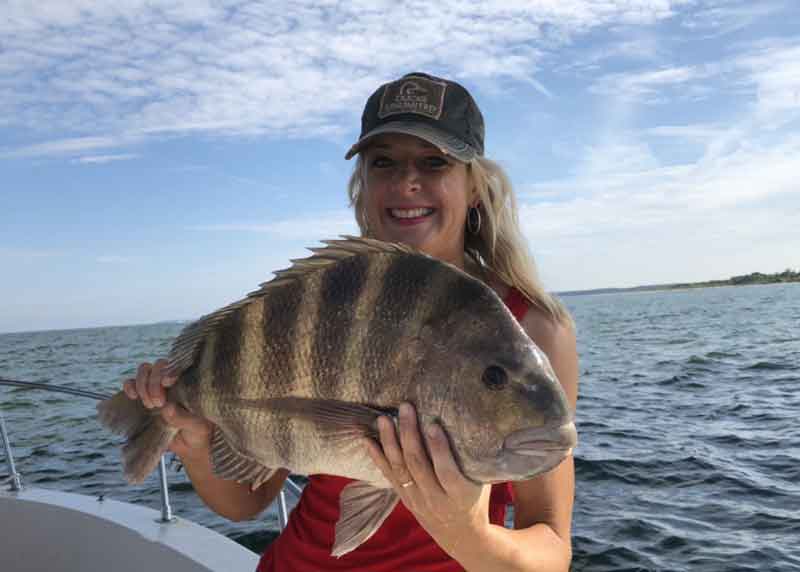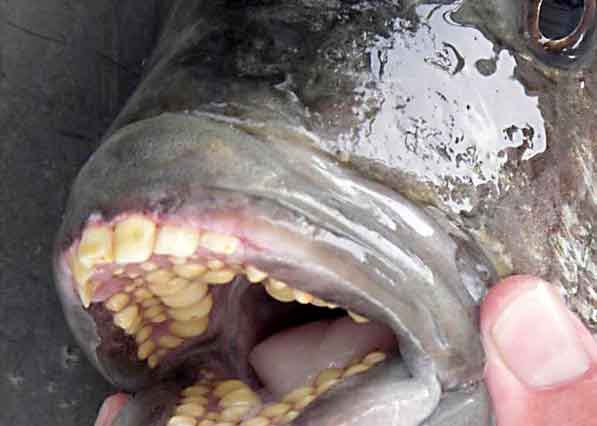While I can’t promise you the “perfect” formula for catching a sheepshead — or a “criminal” as some folks call them thanks to their striped jumpsuits — I can promise you this much: if you do the work eventually you will be rewarded. I have often felt that this fish should come with a warning label because they are so addicting. Sheepshead pound for pound is one of the best-fighting fish in the Chesapeake Bay. Many anglers over the years have asked me “what does a sheepshead feel like when it fights?” and my answer has not changed in over a decade of catching them: The fight of a sheepshead is like the combination of a big red drum and a spadefish on steroids. So if you haven’t before caught a sheepshead not only are you in for a thrilling fight, you will probably be hooked on this species for the rest of your life.

Sheepshead Migration
Unlike fish like tautog which stay pretty much in the same area, the angler who craves a sheepshead must wait patiently for their return each year. They start coming into the Chesapeake Bay around the same time between April and May. Every year, with the initial black drum catches, a few monster sheep are reported as being caught. That is no accident. Sheepshead basically travel with the drum, like groupies mainly in search of two things: food and spawning. (but not necessarily in that order).
Spawning and Temperature Alerts
Sheepshead spawn in various places including the mouths of channel passes and jetties. Their spawning doesn’t usually start until the water temp reaches around 70 degrees Fahrenheit, and they prefer water with high salinity. Once the eggs are released, they float near the surface and hatch within a day or two (24 to 40 hours). As the water continues to warm, then the sheep bite will finally pick up and you will start to see more consistent action. So a good baseline temp to start targeting them in the Bay is about 75 degrees.
Sheepshead Habitat
If you look for areas that have barnacles, the sheep are going to be close by. So where would you find a sheepshead in the Chesapeake Bay? Any of the islands of the CBBT will usually be holding them, the High Rise, and various inshore wrecks such as the Big D, the Anglo African, and the Santore, just to name a few. As you probably already know, once the barnacle becomes an adult, it doesn’t move. So once you find them it will probably be a good place to look again and again. Other things to look for when searching the Bay for sheepshead are signs of life such as spadefish, tautog, or trigger fish feeding, and mussels fixed on structures such as pilings or docks. The diet of a sheepshead consists not only of barnacles and mussels, but also fiddler crabs, blue crabs, hermit crabs, mud crabs, shrimp, clams, and sand fleas. You can use any of these for bait to catch one, the most common bait being the fiddler crab.

Sheepshead Fishing Bait
When baiting the hook (a SSW All-Purpose hook size 3/0 is great for larger sheep and 2/0 is good for smaller fish) with a fiddler crab, put the hook tip into the bottom side of crab in between where the legs are located on either side. Then push the hook up puncturing the middle of the top shell of the crab. Keep in mind the sheep will bite towards the side that the larger claw is located on to get the sweet meat, or to attempt to grab the claw only, so having the hook on that side with the claw (although it can be tricky to not get nipped when inserting it) will be to your advantage. Some folks choose to remove the claw before using the bait with the rationale that the claw will be used to pull the fiddler off the hook. Leave the claw on, however, and not only does the bait look more natural, it stays alive longer and has a bigger presentation. Sheep also love to eat that claw! It attracts them.
Rigs for Sheepshead
The most efficient rig is known as the Carolina Rig. This rig was already featured in detail in the January 2020 issue of FishTalk, in the “Rigging for Tautog: Precision Matters” article.
Fishing Gear
The rod needs to be able to hold up to pressure, because they are incredible fighters and will break subpar equipment. A musky-style rod with IM-6 graphite construction helps in giving extra sensitivity and durability. A six-foot, six-inch rod is good, but longer rod length of over seven feet can also serve as an asset by increasing your reach when fishing pilings from a boat. Spooling up with 40-pound braid is perfect, for this species.
Learning the Bite
A big part of sheepshead fishing involves perseverance and patience. A sheep bite is unique and the angler may not even feel the fish taking the bait. When the fish first grabs the bait, it pushes it to the back of its mouth. When it starts to crush the bait, a tiny increase in pressure is felt. At this point, simply raising the rod tip will encourage the fish to try to suck the bait further back to potentially avoid losing the meal. This causes a further increase in pressure — now, try setting the hook. Also, sometimes the simple lifting of the rod tip and cranking (called the crank method) is all that is needed depending on where that food is located when you first sense the increased pressure, and the sheep will sometimes hook itself.
Looking for Patterns
Learn the depth they are feeding that day by looking for a pattern. Using a Carolina rig is ideal for fishing multiple depths easily, especially when fishing the pilings. The easiest way to investigate the water column is to drop your line to the bottom and slowly work your way back up to the top by cranking a little; then stop and wait; then crank some more stop and wait until you find the depth they are feeding. Investigate this on multiple pilings, before coming to a conclusion. For example, on Monday they may be feeding 10 feet below the surface on mostly Oceanside pilings, but then on Friday they may prefer the Bay-side pilings at five feet from the bottom. Once you’ve caught a sheep or two try to recreate that pattern for the next set of pilings.
Tide Tips
Many people like to sheep fish during a slack tide, because they can use less weight and it’s easier to feel the bite. It’s also less frightening when fishing a boat near the pilings. But sheepshead do like water movement and areas with current. When assessing the pilings try going out and investigating them at low tide, so you can see what is actually located on them at the lower water levels. Then be willing to fish both tides until you gather enough information to know which tides they are biting better on, at which pilings.
On a personal note: Certain years I noticed that incoming tide produced more fish, and other years I noticed the best bite was on a different tide. I would say incoming tide is probably my favorite with these fish. You may come to a different conclusion, but go often and take notes and you may be surprised at what you discover. In 2010, my husband and I experienced 11 citations on my boat the Classic Rockfish in only three trips, with a limit caught each trip during the outgoing tide and near the bottom. Two years later, the bite was mostly during incoming tide at shallower depths, just 10 to 12 feet down from the water surface in at least 27 feet or more of water. Clearly, these fish like to mix it up — so most of all, don’t be afraid to mix it up yourself, and let the Sheep herding begin!
-By Beth Synowiec